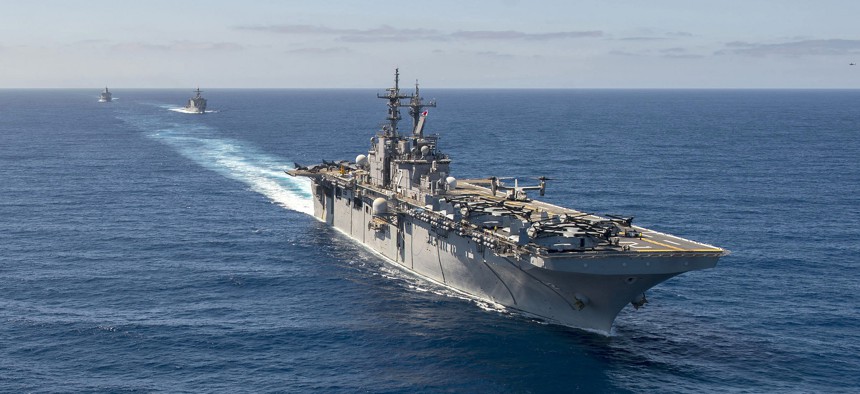
The USS Essex, USS Rushmore and USS Anchorage conduct a simulated strait transit, on March 23, 2015 U.S. Navy photo by Mass Communication Specialist 3rd Class Huey D. Younger Jr
Maersk Tigris: A Warning Bell for Our Contested Maritime Century
In the 21st century, competition between established and emerging powers will be increasingly felt and expressed at sea.
The U.S. decision to escort U.S.-flagged ships through the Strait of Hormuz after Iranian patrol boats fired warning shots towards the merchant vessel Maersk Tigris and forced it into an Iranian port says much about the changing global maritime domain, and how it is increasingly competitive and contested by emerging and revanchist powers.
This is hardly just an American headache. Earlier this week, Iranian patrol boats also fired at a Singapore-flagged cargo vessel transiting the Gulf, which further raised tensions. Far from being an aberration, recent events in the Gulf follow increasingly assertive behavior by Russia, China, and others in waters from the South China Sea to the Mediterranean and the Arctic. And while the U.S. Navy has announced that the escort mission in the Gulf is over for now, it is likely that it will have to do similar things in the coming years and decades. In the 21st century, competition between established and emerging powers will be increasingly felt and expressed at sea.
The Asia-Pacific region has been the primary, and natural, stage for a China seeking to assert itself in the maritime domain. The South China Sea dispute between China and its neighbors has no end in sight, and Beijing is doubling down on its claims by expanding its naval and coast guard presence and by adding landfill to turn natural reefs into artificial islands. China has also turned up the heat in its longstanding dispute with Japan over the Senkaku Islands by extending its Air Defense Identification Zone and sending ships into Japanese waters.
Leadership Briefing: Join Navy Secretary Ray Mabus on May 20 for a breakfast conversation with Defense One’s Executive Editor Kevin Baron. Register now.
The Pacific region is far from the only place where the maritime domain is increasingly contested, or used to express great-power ambitions. Russian aggressiveness and unpredictability has been seen at sea to a surprising degree. Over the past few years, Russia has used its naval power to prod and test NATO and European nations. Sweden, Finland, and the UK have launched anti-submarine warfare operations after credible indications of the presence of submarines in their territorial waters, while warships from NATO nations operating in the Black Sea have had close encounters with Russian jets. In 2013, Russia dispatched warships to the eastern Mediterranean as Washington and its allies were deciding how to react to the Syrian government’s use of chemical weapons.
Meanwhile, annexed Crimea — politically important for a Putin bent on restoring Russian power and tilting the European security order in its favor — also serves as a naval hub that provides easy access to the Mediterranean and beyond. Moscow’s ambitions in the region were recently underscored by an agreement to allow Russian warships to refuel and resupply on Cyprus. And as of this writing, the Mediterranean is the stage for China’s and Russia’s first joint maritime exercise.
The Arctic, which is to a large extent a maritime domain, is also sliding into contest and competition after a long period of stability, peace, and international collaboration. Norway recently cancelled a Chinese satellite receiver project on Svalbard out of concern that the receivers had purposes beyond scientific research. Russian Deputy Prime Minister Dmitry Rogozin recently visited Svalbard unannounced, defying European sanctions that bar Russian leaders from traveling there. In a tweet, Rogozin declared the Arctic a “Russian mecca.”
These are not idle words. Russia is boosting its military presence in the region (it already bases its nuclear-missile submarines there) and pouring more than $4 billion into Arctic ports and other infrastructure.
China and Russia alike are building increasingly sophisticated and capable systems to deny access to maritime spaces. While much has already been written about Chinese ballistic anti-ship missiles and long-range Russian surface to air systems, there is a growing subsurface threat as well. New Russian and Chinese submarines are considerably harder to detect than their predecessors, and air-independent propulsion technology promises to make them formidable opponents. And Russian and Chinese designs are for sale on the global defense market, causing concerns about rapid submarine proliferation to other aspiring powers.
Maritime power is growing elsewhere too, with, for example, Brazil eyeing a nuclear submarine capability, Australia seeking to double its submarine force, and India exploring how to build a carrier aviation capability. All of this comes at a time when the traditionally prominent maritime powers, such as the United States, the United Kingdom, and France, are undergoing austerity and facing declining defense budgets.
Military and strategic mindsets across the west took on an increasingly ground-centric and small-wars character following the 9/11 attacks and the protracted campaigns in Iraq and Afghanistan. During this time, navies and amphibious forces largely played second fiddle to the ground fights in the Middle East and South Asia. After all, U.S. and allied naval power could roam the oceans freely and with little resistance or competition. With the return of geo-political competition the global maritime domain is once again a primary scene for that contest, and decision makers in Washington and among U.S. friends and allies must pay attention to this fact in terms of funding, strategies, and capabilities.
That U.S. warships are once again escorting merchants through the Strait of Hormuz should serve as a reminder that we are moving into a congested, competitive, and contested maritime century.
NEXT STORY: A New Way To Help Our Troops Enter the Workforce
